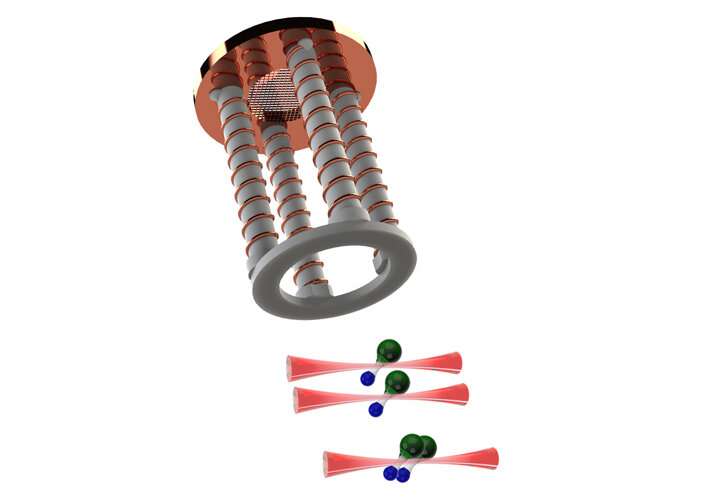Shielding ultracold molecules with microwaves

Ultracold molecules are promising for applications in new quantum technologies. Unfortunately, these molecules are destroyed upon colliding with each other. Researchers at Harvard University, MIT, Korea University and Radboud University have demonstrated that these collisional losses can be prevented by guiding the interaction between molecules using microwaves in such a way that they repel each other and, therefore, do not come close to each other during collisions. Their paper will be published in Science on 13 August.
Upcoming quantum technologies such as quantum computing and quantum simulation are all the hype right now. Huge leaps are made towards their realization in various platforms such as trapped ions and Rydberg atom arrays. Ultracold molecules are another promising platform. Unfortunately, collisions between the molecules lead to loss as if they were chemically reactive, which has limited the ability to cool molecules over the last decade. A team of researchers has now demonstrated these collisional losses can be suppressed by engineering repulsive interactions between the molecules using microwaves.
Eliminating collisional losses and boosting elastic collisions will enable cooling molecules to a quantum gas and bring their application in new quantum technologies within reach. A unique perk of ultracold molecules is that interactions between molecules can be tuned and controlled by the turn of a knob in the lab, using external fields. For example, when the molecules are exposed to microwaves, their dipole moments will oscillate along with the microwaves. In this way we can control interactions between the molecular dipole moments.
Rather than following the microwave field, the dipole moments can also interlock with one another, which can cause either attraction or repulsion between the molecules. Repulsion between the molecules can prevent them from coming close together. "In this way we can shield the molecules from collisional losses," explains Tijs Karman of Radboud University, who proposed this method and whose calculations guided the experiment.
Experimental realization
For the first time, microwave shielding has been demonstrated experimentally in the lab of Professor John Doyle at Harvard University. This experiment uses calcium monofluoride molecules (CaF) that are cooled to a temperature of 100 µK using a technique called laser cooling. These molecules are then stored in individual traps made by focused-down laser light, which are called optical tweezers. Two of these tweezers, each containing a single molecule, are then merged to study collisions between exactly two molecules. To shield the molecules, they are exposed to microwaves from an array of antennas. In this way, physicists engineered repulsive interactions between the molecules that shield them from collisional loss. The loss rate has been reduced by a factor of six.
Cooling to a quantum gas of molecules
In addition to suppressing collisional losses, the repulsion between molecules when they are far apart leads to fast elastic collisions. Here elastic collisions are boosted by a factor 17. These elastic collisions are important for thermalisation. Fast thermalisation and slow loss is exactly what is needed for further cooling of molecules by evaporation, a long-standing milestone in the field. Therefore, the shielding demonstrated here is major step towards creating a quantum gas of ultracold molecules and realizing future quantum technologies such as quantum computing and quantum simulation.
More information: Loïc Anderegg et al, Observation of microwave shielding of ultracold molecules, Science (2021). DOI: 10.1126/science.abg9502
Journal information: Science
Provided by Radboud University




















